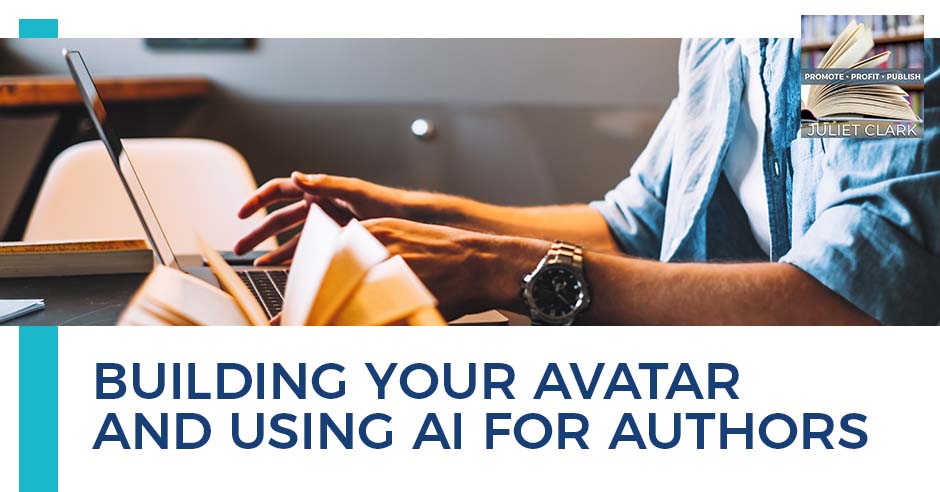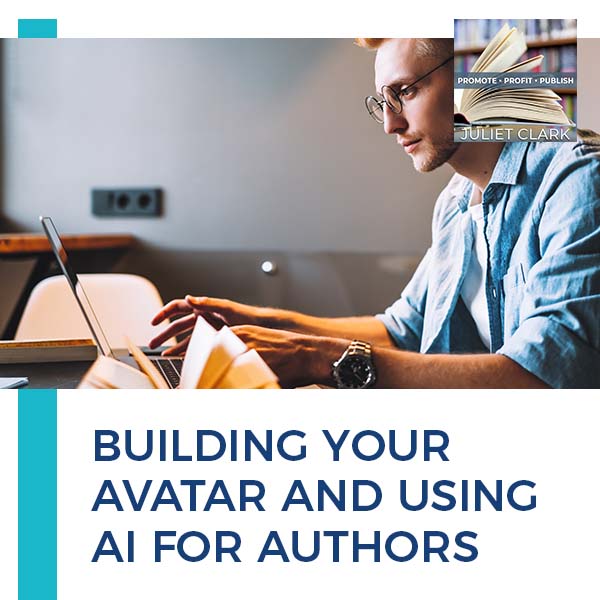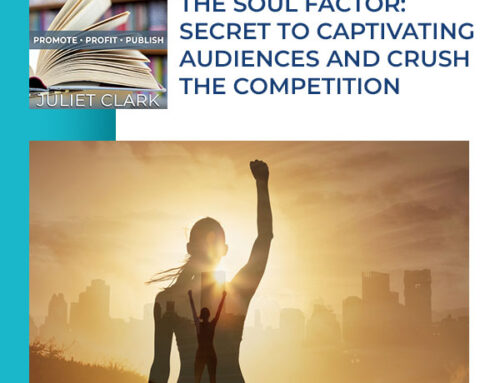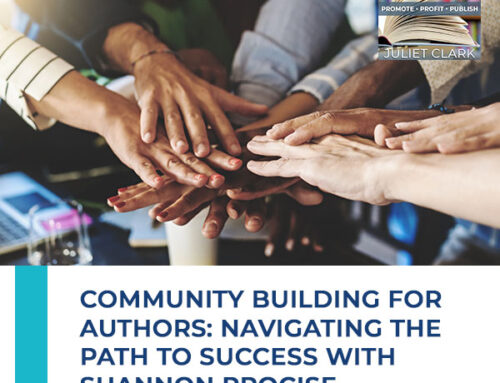
Building your avatar as an author has never been more important that today as we enter a new phase of the digital era – one that is highly-influenced by the rapid development of AI. If you want your book to make it to the people who are supposed to get a hold of it, then there is no way around building a solid digital footprint. In this session, Juliet Clark breaks down the essentials of building an avatar, from getting the right people’s attention to speaking the right language that appeals to them. Grab your notepad and follow this highly-informative walkthrough that promises to be one of the biggest things that will help you attract attention to your book and boost your sales.
—
Watch the episode here
Listen to the podcast here
Building Your Avatar And Using AI For Authors
The training that we’re going to see is one that I gave to Jared Rosen’s DreamSculpt group back in February of 2024. We had major tech problems. I had to rerecord. If this is something that you want to see on the slides, I want you to go over to our YouTube channel, Superbrand Publishing, and check it out there because you can follow along with the slides.
Before I get started, I want to remind you to go over to AIAuthorAcademy.com. We have a class in April of 2024. We are putting on to teach authors how to build their platforms with AI. You may think that AI is out of bounds and scary to use. It’s easy to use. When you’re building your audience, there are many ways to validate, get information, and create social media posts and newsletters. It is endless to find where to get speaking gigs, but you have to know how to do it, and it may require a couple of different platforms.
The big thing is we’re going to show you the exact formula that we use between how we take our videos, how we get our shorts from them, how we take the transcription from the shorts and run it through AI to get social media posts and where we house all that. It’s easy for us to cut, paste, and put it right into social media. We’re going to teach you how to do your content calendar using AI. I have streamlined what I do to where my content calendar is down to about an hour to an hour and a half a month, and we post six days a week. You can tell if you’re doing a little bit less that once you get going with it, you will start building a robust platform.
The second thing is that we now have an audiobook wing of our company. You can find out about it at SuperbrandAudiobooks.com. That will get you an appointment with me or give you the ability to ask for a quote on it. One of the things that’s amazing about this company that we partnered with is that it is known for being the biggest audio company out there, giving you a producer and allowing you to record your own book. There are high standards on all of the audio platforms. To have a producer there to tell you, “You’re huffing. This is happening, or that’s happening. We need to redo this.” It is a big help.
If you’re an influencer or even trying to be an influencer, your book is a nurturing tool, and people want to hear your voice. If you have a YouTube channel, a rumble channel, or a podcast somewhere where people are already listening to your voice, they’re going to expect that book is done in your voice. Grab an appointment if you haven’t converted your book yet. It’s at SuperbrandAudiobooks.com. Stay tuned for the training with DreamSculpt.
—
I’m excited to be here. We had some tech problems. I had to rerecord this. In the end, you won’t have the questions. There were some great questions. If I can remember them at the end, I will put them out there. I’m excited to share this because the number one thing that I hear from authors on a regular basis is, “I don’t have time to build my platform. I’m a solopreneur. I don’t have time to build up a YouTube channel. I don’t have time to build up a podcast. I don’t have time for blogging.” All of that is your trust.
That’s where AI has become such a great tool because we take our blog and run it through ChatGPT. We do a lot with different platforms. We use Opus extensively, but the first thing you have to do with this is get your avatar ready. A lot of you are playing with AI, and you don’t understand it. The basis for a lot of work and streamlining this work in a meaningful way to keep you on track with audience building is you must have a digital footprint to attract readers. That is unavoidable.
You must have a digital footprint to attract readers. That is just unavoidable right now. Share on XThere is so much that has to be done with platform building. I’m going to show you a formula in a minute that will explain not only why you didn’t get a traditional contract, or you haven’t, but the way that you can estimate based on audience size, how many books you’ll sell, and you’ll be amazed at what that looks like at the end of the day.
Audience engagement matters because the size and engagement of your audience formulate what you can expect to sell for books. The bare minimum to get a contract from a traditional publisher is they want to know that you can sell 5,000 books in the first year. The way they came up with those 5,000 books is they took your total social media, podcast, YouTube, TV show, radio show, and your email list. They look at those numbers and the engagement. They determine if this book will be profitable.
I can tell you from talking to a couple of agents. They don’t even look at your proposals. When they get a proposal that’s been written by you or someone else, and when they look at it, they go straight to the audience size. They do that not because they don’t think you have great content but because they can’t sell a book to a traditional publisher who’s in the business of making money from your books. They can’t sell it unless they can provide an audience that will meet these numbers.
I threw my numbers in here. You can see that I have 17,000 on social media. I’m only on LinkedIn. I get about 22,000 podcast downloads monthly. My list is at about 5,000 people. I have to be honest. I am not great at list building because I look at my open rate and start deleting it. That was the strategy that someone who started out in this industry at the same time I did.
She writes books for a living. She writes fiction books. Her list was the main focus of the building. She gives away old books to build the list, which, if you have a back catalog, is a great idea, but even better if she goes through her list about once a quarter and she says if you have an opening in 30 days, she’ll send out an email and say, “I’m deleting you because you haven’t opened in 30 days. If you’d like to get back on at some point, please do that.”
What did that do for her? She has a clean list of about 20,000 to 25,000 people. She got a book out there with co-writing with Nora Roberts. Because of the size of her audience, her work, and what she’s done not only to build her platform but to get out there, she is now a New York Times bestseller. Suppose you want to be a New York Times bestseller because you’ll get more speak, and there are a lot of advantages to it. In that case, I will tell you that to work with anybody I know on building that where they build your platform, write the book, and get the book published, you’re looking at about 130,000 to 150,000, depending on who you go with. You have to build it. There’s no way around it.
Artificial intelligence can streamline this process, but here’s the problem. It is a garbage-in, garbage-out system. You are teaching it, and it is a large language model. If you put garbage in and you’re teaching it with garbage, your output is going to be garbage. AI can only give you results based on the specific information that you input, and we call that information a prompt. Whatever the prompt is, that’s what you’re going to get. When I put things in, I’m specific about the tone I want to use and the audience that I’m catering to. That’s why we get such great stuff that connects. Even though I go in and finesse it because you don’t always want to be AI all the time, but a lot of times, I will go in and finesse the newsletter or an email because I don’t like some of the language on it.

Building Your Avatar: AI can only give you results based on the specific information that you input. It’s garbage in, garbage out.
Connecting With The Right People From Day 1
That’s why we’re going to jump into how you can build that avatar stronger, that you are connecting with the right people from day one, and that your book is written in the language that speaks to the right people. I said, “The more focused you are with the input, the better your output results will be.” What we’re going to talk about is how to rebuild your avatar. We’re going to do this specificity and have you do market research.
One of the big things I learned from advertising and working on a $1 billion account is that those ads you see on TV are expensive. Those radio ads and the talent are expensive to produce for an advertising agency. The brands spend an enormous amount of money on market research, sometimes even focus groups. I used to be that person. I don’t know if you remember. In the ‘80s and ‘90s, you might’ve gotten pulled over in a mall and asked, “Would you like to come in and see this video?” Hollywood did it a lot with the multiple endings to movies. You’d go into a room, and we’d show you. We’d get feedback. There’d be lots of M&Ms and Diet Coke. I was chubby back in those days from all the M&Ms. What it was was that feedback.
If I went into a mall nowadays, grabbed somebody, and said, “Will you go in the back room with me?” They will call the cops. Back in the old days, that’s what we do. There are ways for you to do a focus group online, and I encourage you to do one, learn how to do one, and do one because market research is invaluable. We’re going to go over audience overview, brands and influencers, press and websites, and consumer semantics and move into what I call gold language.
Audience overview is building your demographics and psychographics. For most laymen, small businesses, book writers, and content writers, this is where they stop. It’s important, but it’s important that you don’t stop. The first thing we’re going to look at is age. What is the age of your audience? The reason I say that is different age groups communicate in different ways. My key age group demographic is 55 to 80. I’m getting those second-wind people who have a boatload of experience in what they do. They’re going in to be consultants or coaches in a particular industry. Some of them are like, “Retire is retiring. I don’t want to be tired. I don’t want to be that man in the Barka lounger yelling at CNN on the television, whatever that stereotype is of older people.”
What that means is I’m working with a group that has not grown up with technology. When I start teaching them technology, they’re afraid, but that also means they’re not huge texters. They don’t like it when they get a sales pitch via text. They think it’s annoying. I get them all the time, and they’re annoying. They are more of the relationship people, the verbal. I wish our whole society were like this because we were much more connected when we were verbally speaking to each other.
You’d be amazed at the power. I’m going to give you an example. My mother used to do this to me. She would text me, and it’d be all cap. I’d be like, “Mom, quit yelling at me.” She’s like, “I’m not.” It would turn out that she was older, and her caps lock was stuck. There are a lot of misunderstandings that can help with those forms of communication. Understand the way that your particular age group demographic communicates because that’s one of the first keys.
The second is gender. When I say gender, if you cater to women, women communicate differently than men. When you are writing copy, courses, teaching, or a book, if it is for women, you are going to want to connect on an emotional level because how we connect is feelings. I know men hate this, but it is what it is. If you work directly with men, they respond more to practical facts. You want to make sure that whatever you’re doing is based on that. If you have a mixture, it’s harder because you have to mix it all together. It can be difficult to do with that, but gender is important. Do you work with men? Do you work with women? Do you work with both? How are you going to communicate and pair how you are going to communicate with that age group?
The next we’re going to get into is the educational level. You want to be able to communicate in a way that isn’t condescending. You are the big leader. You’re using big words. People who are college students or have never graduated from college. The truth is that most people communicate on a seventh-grade level. Like it or not, that’s the truth.

Building Your Avatar: Most people communicate at a seventh-grade level whether we like it or not.
There is something that happens. I don’t remember the name of the group that does it. At the end of every presidential election, they look at the communication of the winner versus the loser. I’ll give you an example, whether you agree or not. I don’t mean to get political on this, but in 2016, they determined Trump won because he communicated at a middle-school level.
Is that how we all communicate? No, but if you are communicating to a broad audience, you want to communicate at their level. If you look at Hillary Clinton, she assumed a postgraduate level of communication, which was offputting to a lot of people. I have a postgraduate degree, and I found it off-put. You have to communicate at the educational level of your people.
Where that even gets more intense is, are you a train-the-trainer? Are you using jargon because you’re training the people? You’re a psychologist, and you train other psychologists. You are going to use psychological jargon. If you are not a train the trainer, chances are, you’re going to have to dumb down that language because if you fire hose people with that aren’t at that level with advanced, they’re going to give up. You want a high rate of return and rate people who finish your programs.
Years of experience matter tremendously. This goes back to that train the trainer. If you’re a train-the-trainer and you’ve been in business for several years, chances are people who have many years of experience are not going to hire you. You need to look at the experience level of the people that you’re working with. It’s important.
Top majors in education, if you are working with people who are in that 25 to 35 range, they don’t have enough experience in an industry. They’re going to go back to what they majored in. This is a tough one because a lot of people don’t end up with jobs that they major in. A great example is when I worked at Price Stern Sloan because they had gardening books. I have a degree in Ornamental Horticulture. Even though I started out using a little bit of that knowledge, I was plunged into the publishing world, where I had to learn a whole bunch of other things, take that knowledge, and make sure that it was correct. That can be for those people who haven’t been in an industry for a long time.
Look at the top industries you’re working with because when we get into the gold language, I’m going to talk about the industries that use some of these gold. The letters that I’m going to articulate, you want to use the language of that person. I’ll give you a great example and a preview of that. The organizers in GOLD tend to be lawyers and accountants. You’re going to need to learn a language that connects with them. It can’t be a frivolous sales copy that they need different requirements.
Go back through your list. This is what I want to assign you guys to do. Go back through your past clients and figure out what their education is. If it’s something with majors, ask. You might be able to find this out on LinkedIn because a lot of times, people will put the college that they went to and what they graduated in. The age, the gender, and all of this stuff we’ve gone through, go back, look, and see if you can see a pattern in that. What marketing is all about is looking or marketing research and finding those patterns that you can use for your marketing.
The metro area is important. I hear complaints, “I ran ads.” You ran ads to a general population. I know where my top five metro areas and my top five states are and where I get business. What I would do is pull out a sheet of paper, write it down, go through your client list, or go through who you’re meeting where you’re networking. Where are those people from? Write down the five top metro areas and your top five states. My top five states are California, Texas, Florida, and Arizona, and I get quite a bit from New York but not as much from New York as the others.
When we were looking for speaking gigs for her program, she was in Eastern Ohio. We were looking in Pennsylvania and Ohio. Could we go up? New York is right there. She didn’t want to do more than a day’s travel if she was getting paid just because she has a robust psychiatry practice. If you know that, you can start focusing on those connections on LinkedIn and Facebook and seeing where those people are.
Interest and skills are the psychographics area. This is about where you are going to meet these people. What are they interested in? If they’re leadership coaches or someone who teaches leadership, you’re going to go and look at companies that need leadership coaching. You’re going to connect with the HR people. If you want public speaking, you’re going to connect with those people who are like-minded. Not only skills, but you’re going to look for those people who have the topic that you’re looking at.
When you meet people out in public, are they interested in education, children, arts, and culture? I’m a publisher, but I’m also a painter. I need a lot of painters who talk to me about doing books. One did, but that’s someplace where you’re being exposed to people who are like-minded and who might want to do what you do. Get into that when you’re looking.
I’ll give another example of top interest. We had a children’s book that was released back in November. It’s an environmental book. This author, Sandra Roe Martinez, goes out. She takes her child to beach, river, and park cleanups. She takes her books with her. They talk about it. She’s now creating a club for kids that is low cost where they can come and get more information and they can find out what more they can do for the environment. Having that understanding where these people are at can give you a foot in the door to connect with them.
The importance of this is to know who we are talking to. There’s a saying, “When you write something for everyone, it’ll be read by no one.” It can’t be general. It’s also how and where you are delivering content. If you are a psychologist, you are not going to be a great thing on Facebook. Over on LinkedIn, it’s much better.
When you write something for everyone, it will be read by no one. Share on XGo Where Your Audience Is Hanging Out
I’ve told you guys this story before about the client who came to us in 2016. She had a program that was solo to the CEO. She taught people who were CEOs and solopreneurs how to work on their business instead of in their business. We highly encourage you. Your people and your CEOs are over on LinkedIn. She insisted she was going to stay on Facebook, but it was a complete flop. It was because she didn’t look at where she was delivering the content. Were her people there?
If you know who your people are, your copywriting is going to fit. A great example of this is Prima Sero. She has an older audience like me. She tends to use the language of our older audience. With some of the language or slang she uses, the younger generation laughs at us. Book development is your voice. When you know who these people are and you go back to those professions, you can see you can use the right words for action-takers, nurturers, and analytics. Who are these people, and how do they communicate?
The next area is brand and influence. This is where your audience is hanging out. Many of us collect an audience on social media. I do a lot of in-person, not as much since 2020, but social media is my main delivery. I did this based on Brené Brown’s profile. When you look at Brené Brown, the same people that follow her follow Simon Sinek, Elizabeth Gilbert, and Marianne Williamson. What this tells me is that I need to go over and find out where the other places these people are. You can see Simon Sinek on Twitter, Facebook, and Instagram, not on Pinterest, which is a great place to sell books, and he’s on YouTube. If I were someone who is a spiritual behavior person like Brené Brown, I would see that most of the people who are also like her are in the same places, with the exception of Daniel Pink. Most of them are on Instagram, Facebook, Twitter, and YouTube. You want to be in those same places.
For podcasts, you might go back and do a survey. Ask your existing audience, “What are the podcasts you listen to most?” I listen to audiobooks and podcasts when I don’t have clients on the line because I’m sitting there working. I’ll have it playing in the background. The same thing with Brené Brown, John Maxwell, and Wayne Dwyer. I don’t think he’s on here anymore, but Wayne Dyer used to have a podcast.
TED Talks is soul. Find out what those podcasts are not only because you want to listen to them and find out the topics, but when you get your speaker sheet together, your book, and your book one sheet, you might want to see if you can get yourself booked on those shows because they might have the same audience. It’s important to check out the podcast.
The same people I was talking about with Brené Brown also have YouTube channels. You can see how many subscribers they have. What does this look like? I’m amazed that Elizabeth Gilbert only has 11,800 subscribers. She’s one of my favorites. If you haven’t read Big Magic, it is the best book because it tells you about it. If you have a big idea and you don’t act on it, the universe is going to take it out of your head and give it to someone else. How many times have you ever sat online, seen something new launch, and said, “I wanted to do that. I could do that. That could’ve been me.” I’ve had one or two things that I’ve done that with. Check it out.
If you have a big idea and you don't act on it, the universe is going to take it out of your head and give it to someone else. Share on XLook at the YouTube channel. You can put your earbuds in. When you don’t have clients on the phone, you can listen. What are the relevant topics they’re talking about? Can you spin off of those? You don’t want to copy them, but you definitely want to see how they’re doing it and why it’s effective. The importance here is relevant conversations, a study of social media, content deliveries, and who in your audience is following this. This informs your press and website, which we’re going to go into next.
Press and websites are another area to take a good look at where your audience is consuming their information. Websites, I don’t get a lot of this. I ran the Brené Brown thing again, and I wasn’t happy with the results, but here’s why you want to look at the website. If you are someone like Brené Brown, go over to Brene Brown’s site and see what she’s doing.
What is her lead magnet? What are her programs? Are her programs one-on-one? Are they downloadable consumable work at your own pace, which we’re going to see a lot more of in 2024 and 2025 as money gets tight? Does she have group programs? How does she sell her information? That’s what you’re looking at. If you are like her, she is a competitor. She may be a big influencer competitor, but I would encourage you to make a list of your five biggest competitors out there, look at their sites, take notes, and figure out what they’re doing successful and how you can do it. Do not copy it, but do it with your content.

Building Your Avatar: Make a list of your five biggest competitors out there and look at their sites. Take notes and figure out what they’re doing successfully.
Press outlets, we live in a divided America. You want to be able to take your book. You have some favorite news channels that you listen to. You resonate with them. You think like them, but what’s important about it is knowing where your people are at but going to the other end of the media spectrum. If you are a left-leaning person, hold your nose and watch Fox or Newsmax. I can’t even think of what the other ones are over there. I listen to a lot of alternative media. I don’t bother with these anymore and I have personal reasons for that.
The reason you want to do that is because when you discount a whole other segment of media, you are discounting your reach with your book. Here’s a great example of why I encourage you to do it. You’re listening to what these people are talking about and their spin. Leslie Michaels had a fabulous book on feminism. We had her with the booking agent. She kept telling the booking agent, “I want to be on CNN and MSNBC.” The problem was that if she was competing with a lot of big-name influencers on those liberal channels, one time, we would lose out to Maureen Dowd. If you’re given a choice between Leslie, a relative unknown, and Maureen Dowd, the shows are going to choose Maureen Dowd.
Here was the problem. Leslie didn’t like the conservative media. Fox and Newsmax were reaching out. There was a periodical that was reaching out to her that was more conservative. She kept telling our media booker, “No.” On that side, she had no competition. She could have been spinning and talking about her book in a different way than she would’ve over on a liberal network. It is important that you know where the information is being consumed by your audience, but it’s important that you listen to the other and figure out how your book is relevant. You can get your foot in the door on their media.
Language Matters
The important is relevant conversations. For media websites, look at the key buzzwords they’re using in their copy because that’s important, and how monetized content is delivered. If you’re struggling with selling things on your website, you might go over, look at theirs, and say, “I don’t have a cheaper alternative to what I do. I ran this group program last year. Why can’t I make that into a downloadable file that I can sell to somebody who doesn’t have the funds?” I can drive traffic from my book to where the lower-cost product because it’s rare that you go from a book into a big ticket. A lot of times, people will stare at you because they want to get to know you better, and that book is your first step.
Consumer semantics is about how people find you. I find that most of you will tell me your keywords, but when I run your book through AI software, AI tells me you’ve got a different bunch of keywords, which is not a good thing because we use keywords for every book we upload. One of our great opportunities as a publishing company is that we can put one set of keywords into Kindle. We can put a second into Core Source, which is the eBook. We can do a third into Lightning Source, which means that when it all comes together on the distributor, there are tons of keywords there.
We will ask, “What are your 25-key words?” We have AI programs that I can use to put your book up in PDF format, and I can get an answer. Here are the 25 keywords for this book. I have stuff to advertise. I know what needs to go in my copy. I know what needs to go everywhere, and I am promoting this book. Keywords are important. I’m going to talk about an AI course at the end. One of the things that I will share with you is what we use for our keywords. You can upload your book at intermediate stages and make sure that you’re using those keywords effectively.
I’m not going to get deep into hashtags because a lot of people don’t use them, but I know when I use them on LinkedIn, and I know a lot of others do. If I go in and put an author platform in there, a lot of my stuff will come up. It’ll also come from other people and competitors who are using the author platform. I can see what they’re producing. I can see the hashtags they’re using. You might want to do that.
If you go over and you are looking at Brené Brown and you see she has 3 or 4 hashtags that she’s using that isn’t her name, don’t use her name. You can do some of those. When people are using the fat hashtags, they will get your articles and her articles. You might get some random people that way that go over and go, “I like what this person has to say and Brené Brown. I’ll go check him or her out.” This is a way for you to get maximum searchability and to be able to infuse your content. It’s searchable. Build the SEO not only on your website but also on your book platform, and make sure that your publisher has the words they need to infuse the book publishing platforms with that. That is important.
Finding the gold. I kept hearing from my clients over and over, “I’m putting this language together. I’m running it through ChatGPT, but nobody is connecting.” This part is because you might have developed your avatar, but you don’t look deep into the language, how to close a deal and a book, and what to do when presenting to these people. Your language matters when you’re speaking to an audience.
Your language matters when you're speaking to an audience. Share on XI’m going to go through this quickly. I should have a quiz by the end of March 2024 where you can drop, drag, and get all of the attributes of these people, but this is a quick and dirty on it and an explanation about why language matters with your audience. AI requires that specificity to train. The language you use in your book and presentations, especially if you’re selling something, has to match. It all has to match the language that your audience uses. If you are an expert and you’re using jargon with a non-expert audience, chances are you’re going to lose them. That’s because you’re not speaking their language in one way, but there are other ways that you may not be speaking their language.
I’m going to go through these four and give you an example of why this is important. Our first archetype is the go-getter. The Go-getter is an influencer and action-taker. They’re looking for continuous growth and improvement. They’re confident, sometimes overconfident. They’re on top of cutting-edge things. They want to be the first to use something to be the influencer or influencer on new platforms and things to do.
I’m a go-getter. Most of my audience is go-getters. You may find some of the same, or you may not find some of the same. We attract like-minded people. That’s where that go-getter comes in, but here’s the deal. When I’m talking to somebody who doesn’t fit this, I have the opportunity to say, “I don’t think we’re a good fit.” If you’ve ever had a bad client or someone who’s picked up your book and they don’t have a good opinion of it, most of the time, it’s because they’ll suck the life out of you. You want to avoid it.
These influencer people, when I say action takers, the way you close someone like that is you talk to them, and they think with their gut. They hear it. They’re not impulse buyers. They’ll gut-check and say, “Yeah, this sounds like something I can use. I can incorporate it in X, Y, and Z.” When you’re closing a deal or presenting to these people, you have to keep their attention. They’re easily bored. If you spend any time with me, you’ll know that. I have ADHD, but I jump a lot. I avoid shiny objects, but I jump a lot because I get bored with things.
The next is the organizer. Organizers are analytical thinkers. They’re also visionary leaders and long-term planners. What makes them good visionary leaders is they don’t look at now. They look at where we are going to be a year from now. Where are we going to be five years from now? Where are we going to beten0 years from now? It makes them results-driven because if they’re not reaching those goals, they’re not happy with it. They also are solid negotiators. I can tell you that. I’ve negotiated with many organizers. Organizers is the second language that I work with best here.
This is why taking this back to rebuilding your avatar, these are people like accountants, lawyers, people who sit down and think about these things. These are financial planners and numbers people. You want to be able to speak to them in that way. They’re going to want to know, if they read your book, “What are the results I’m going to get from reading this book because I don’t want to waste my time with a flock book.” You have to have this in it.
You might want stats. If they’re numbers people, they’re looking for numbers. Keep this in mind, not only when you’re writing your book, but if this is your audience, your social media posts are aimed in that direction. Everything is named in that direction. We had an organizer who wrote a book whose specialty was tech. It’s interesting because they’re similar, but they’re not the same. She has to do a few newer things to connect with that audience.
The next is the lover. These are people who are spiritual people. People like psychologists would be nurture people. Some doctors, although doctors, tend to be analytical. They have to be for their job. These are people who are curious, creative, and open-minded, but they’re non-conforming. It might be that they take an idea. They turn around and say, “I’ll do it this way.” It’s more effective for them. They’re servers and their clients or servers.
The reason this is important is while I might close an influencer with the influencer that I was talking about, the go-getter. The lover is different. I’m going to have to nurture them, answer questions, and give them some scenarios. It’s different. They need a much softer touch. I’m not soft. I can do it, but it takes effort sometimes to do it.
The next one is the documenter. The documenter is the critical thinker. They don’t make decisions quickly. They’re fact-driven, detail-oriented, and resistant to change. With a documenter, you want to come to the table with statistics and studies. If you came into it and you said, “Here’s a few research study. It shows that 45% of people are blah blah,” They’re going to appreciate that you threw it out there. It’s going to give you cred, but they’re going to go look it up. They’re not going to take your word for it. They’re not only that fact-driven, they’re science-driven. They’re going to go look things up.
These are people that you’re going to have to take your time with. These are tech people and engineers. When I was in real estate, I had an aeronautical engineer who very wealth. He invented plane parts and things that go on planes. We were looking at a house out in the canyon in Los Angeles. He said to me, “What if that hillside catches on fire? Will my roof catch on fire? Do I have enough clearance? How far away is the golf course from the irrigation system?” I sat there. I was like, “This is like when my son was five. Why is the sky blue?” These are people who think through everything.
Consider it for a moment. If you ask me and an engineer to build a bridge, I could build a bridge, but I wouldn’t encourage you to drive over it. That what-if guy is the guy you want building your bridge because he’s thought of every possibility of how it would fall down. That’s why this is important. How you speak to those people and how you write that book, you want those stats in it. Those are the people who are going to go to the back of the book. They’re going to look at the footnotes. They’re going to look at the section in the back that has all the links and where to find things. That’s those people.
Language matters, and it’s important for you to learn how to identify these people because they are the people that you’re going to attract to social media through language. They’re going to be attracted through your content development. Whether you have sassy like mine is, mine is influencer sassy fun. Let’s do this. That’s the thing you want to keep in mind when you’re writing your book.
For your campaign launch, you want to use the language that attracts people to that campaign. Here’s a scenario of why this matters. Imagine, think about the go-getter for a minute. If I have written my book for a go-getter, but my audience is documenters, the documenters are going to be looking for those scientific facts. They are detailed data people. The go-getters are big-picture people. I’ve turned off not only the documenters for my book. If I’ve written it for the go-getters, but I may not have been using language all along, that’s attracting those go-getters. If I want to close that documenter, I’m going to have to do it in a gentle way, where I give them the space to think about it.

Building Your Avatar: When you’re writing your book and also in your campaign launch, you want to use that language that attracts people to that campaign.
If you’re closing a deal with a person like that, they’re not going to close on the phone. They’re going to say, “Send me a proposal. I’ll ask you questions. I’ll think about it. I’ll research everybody else on the planet. I’ll be back in a month because that’s who I am. I’m the documenter.” You can see that the way you talk to these people and understand the audience and their language are important.
What’s Coming Up
As part of that, we have an AI platform building coming up in April. What we’re going to be teaching in that course is niching your avatar. We’re going to get deep workbooks working on that first week. We’re going to be working on that avatar and rebuilding it. In the next following week, we’re going to be getting into the gold language identification. Who is it? How do we talk about it? What are the presentation skills? We should have the quiz. You should know what that person is going in.
In week three, we’re going to spend on AI platforms for better results. I’m going to walk you through some AI platforms, which ones you can load a PDF into and ask questions. Which ones do you need to chunk down? A lot of the GPTs don’t do what we call chunking well. You want to move to another. I’ve used Bard, which flipped over. They changed their name to Gemini. I’m not a big fan of that one. I tend to use some other ones. What are the ones you use on YouTube?
In week four, I’m going to show you using Notion, YouTube, Opus, ChatGPT, or another platform on how we streamlined our process. Our content calendar is done quickly, and how you can do it as an author because it is important. Most of you are solopreneurs, or you have a team. If you’re the rainmaker like I am, you don’t have time to spend 5, 6, 7, 8, 9, to 10 hours a week doing that. You need to be on the phone with clients, servicing your clients, closing new clients, and keeping that pipeline going. This will be helpful.
If you’re also writing a book and building a platform, that’s a lot of time. That’s a big commitment. That course is $1,497. Reach out to me. We don’t have the landing page yet, but if you go to chat with me, you should be able to set up an appointment. Talk to me about it and see if it’s right for you. If you have questions, since we didn’t have the Q&A at the end, you can send me questions at Juliet@SuperbrandPublishing.com. I don’t give out my email, but I understand that the tech created a weird situation with this.
Something we have coming up on the first Friday of every month, unless there’s a holiday, we do author training. March 1st, 2024, is going to be Fran Acero, who is the senior tuber. She’s going to go beyond the pages, unveiling profits for authors. She has figured out how to use the membership function on YouTube. She has a substantial membership over there, which might be something that some of you are interested in. At the bare minimum, whether you are on YouTube or all of you should be on Rumble, anything that you’re doing on YouTube you can do over on Rumble, less the censorship that YouTube does. You have to be careful what you say over there because they will demonetize you.
If you want to sign up for this, go to BAMagLiveTraining.com and grab a spot. The last time Fran taught something else was back in December. It was the biggest turnout we’ve ever had. We had a tremendous amount of people because everybody is mystified about how YouTube works. What a supercharge. We use TubeBuddy. We’ve learned a lot from Fran about how to supercharge the YouTube channel.
I already talked about the AI Author Academy coming in 2024. We’re going to take the garbage in, garbage out of this. You’re going to be putting in clean, great stuff. The reason this is important, and I probably should have used this example while I was talking, is we had a client last summer who came to us for a quiz. She had ChatGPT write some sassy, fun copy for the event that she was having. What she didn’t do was build that avatar and use the right language. It didn’t work.
The copy looked fantastic, but she was catering to influencers. Her audiences vacillates between that organizer and that documenter. We’ve gone back and tweaked a little. She’s getting better results with it, but she put her way of speaking into ChatGPT. What she got back didn’t match her audience because she’s a bit sassy, but she’s an SEO geek. It is important to streamline this and get all the avenues in. The course is $1,497. If you sign up now, it’s in April. It’s an easy two-payment plan, or you can pay all at once.
We have a new product. We partnered with the largest self-narration company for experts. We now have Superbrand audio. If you have a book already or you’re thinking about adding the book to your book launch program, this is great because you can do one launch with your eBook, softcover, hardcover, or whatever you’re doing. A lot of times, we record this after your initial book’s release. You have another release six months down the line that’ll give your book a second win.
The point of the self-narration is that we have two ways to go. You can self-narrate with a producer. They give you a producer. They take you through the process, and you get a fully formed product at the end or they can hire talents. It can be done both ways. If you’re someone who has a YouTube channel or a podcast and you’re out speaking a lot, people are going to want to hear your voice reading the book.
One of the things that happened was in 2014 or 15 because I had her on my podcast back then. It was a different podcast called Ask Juliet. I had Dory Clark on. She’s a big influencer. With her very first book, her publisher got the talent to read it. I listened to that first book. I listened to her latest book before the interview. She read her second book. That was one of my questions because reading her second book was more compelling than having the talent do it.
The other thing about this is that since 2020, audiobooks have captured about 45% of the market. The reason is that many people have left Corporate America. They’re still in Corporate America, but they’re not going to the office where they are on you wearing earbuds while you’re working. A lot of people working at home. If they don’t have jobs that require them to be on the phone or computer, they will sit there like I do when I don’t have clients and listen to audiobooks.
I’ve been an audible person since 2008 or 2009. I go through seven books a month on average. I shut down on the weekends. I try not to do any work and I don’t listen to anything even remotely political like I would on a weekday. I’ll book a day on the weekends with that. If you don’t have an audiobook yet, contact us at Superbrand Audiobooks. We’ll see if we can set it up.
The other thing that I love about this new platform is that we have what a lot of people don’t, which I love when I am listening to an audiobook. We have a feature where they will interview you at the end. There will be about a fifteen-minute interview at the end of the book. That is a great relationship-building tool because people get to know more about you.
I have one author in particular that I listen to the interview at the end of the book. He writes spy thriller things. I love his interviews because he talks about why he wrote the book, how he researched, and the nitty gritty stuff that you want to know. That is it for now. I apologize for the tech. It was a miscommunication. I tried to record Jared Rosen, and I got a piece at the end where it showed that Jared turned it off and it turned mine off. It’s a mess. But you live and learn. Tech is not always your friend.
For any of these, please reach out. We’re always here for you. I highly recommend this course. If you’re struggling with content, content is your trust builder, and you want to build trust with your audience. Take a good look at that formula that I had back at the beginning and see how many books you’re projected to sell now because when we start that course, I’m going to ask you, “How many books do you wanna sell? What are your goals? How are we going to get there?” See you guys soon. Thanks for reading. Bye.
Important Links
- DreamSculpt
- YouTube – Superbrand Publishing
- AIAuthorAcademy.com
- Big Magic
- BAMagLiveTraining.com
- AIAuthorAcademy.com
- SuperbrandAudiobooks.com
About Jared Rosen
 Jared Rosen is the founder Of DreamSculpt. As an innovator in digital media publishing, he has published over 50 media enhanced e-books for many best-selling authors and filmmakers and has published dozens of books in print. Jared is the author of three books including the groundbreaking book The Flip. As a thought leader he has presented in venues ranging from TED X Malibu, to McKinsey and Company, Sydney, Australia. In 2000, Jared co-created the Children’s Emotional Literacy Project endorsed by Mayor Richard Riordan and Norman Lear.
Jared Rosen is the founder Of DreamSculpt. As an innovator in digital media publishing, he has published over 50 media enhanced e-books for many best-selling authors and filmmakers and has published dozens of books in print. Jared is the author of three books including the groundbreaking book The Flip. As a thought leader he has presented in venues ranging from TED X Malibu, to McKinsey and Company, Sydney, Australia. In 2000, Jared co-created the Children’s Emotional Literacy Project endorsed by Mayor Richard Riordan and Norman Lear.
Love the show? Subscribe, rate, review, and share!









Leave A Comment